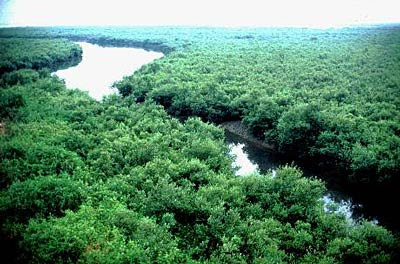
Kuakata Beach of Bangladesh: see Beach of the world
Kuakata is a panaromic sea beach on the southernmost tip of Bangladesh. Located in the Patuakhali district, Kuakata has a wide sandy beach from where one can see both the sunrise and sunset. It is about 320 Kilometres south of Dhaka, the capital, and about 70 Kilometres from the district headquarters. The Kuakata beach is 30 km long and 6 km wide. On 13 September, 2007 government had announced a red alert in Kuakata as caution for a possible Tsunami.The name Kuakata originated from the word 'Kua'-the Bengali word for “Well” which was dug on the sea shore by the early Rakhine settlers in quest of collecting drinking water, who landed on Kuakata coast in the eighteenth century after being expelled from Arakan (Myanmar) by the Mughals.[3] Afterwards, it has become a tradition of digging Well in the neighborhoods of Rakhaine tribes for water.
Kuakata offers a full view of the sunrise and sunset from the same white sandy beach in the water of the Bay of Bengal.
Locally known as Shagor Khan-Ya (Daughter of the Sea), the long strip of dark, marbled sand stretches for about 30km. The long and wide beach at Kuakata has a typical natural setting. This sandy beach has gentle slopes into the Bay of Bengal. Kuakata is also a sanctuary for migratory winter birds.
 On the eastern end of the beach is Gongamati Reserved Forest, an evergreen mangrove forest and snippet of the original Kuakata. When the Rakhines settled in the area in 1784, Kuakata was part of the larger Sundarbans forest. However, the Sundarbans is now at a distance of one-hour by speed boat. As a mangrove forest, Gongamati, like the Sundarbans, offers some protection against tidal surges, however it too is being threatened by logging and deforestation. The best way to reach the forest is by foot or bike along the beach, where a flock of flag flying fishing boats can be seen trawling the coast. Choosing to visit Gangamati in the late afternoon is a perfect time to watch the sun caste shadows on the abstract exposed mangrove roots.
On the eastern end of the beach is Gongamati Reserved Forest, an evergreen mangrove forest and snippet of the original Kuakata. When the Rakhines settled in the area in 1784, Kuakata was part of the larger Sundarbans forest. However, the Sundarbans is now at a distance of one-hour by speed boat. As a mangrove forest, Gongamati, like the Sundarbans, offers some protection against tidal surges, however it too is being threatened by logging and deforestation. The best way to reach the forest is by foot or bike along the beach, where a flock of flag flying fishing boats can be seen trawling the coast. Choosing to visit Gangamati in the late afternoon is a perfect time to watch the sun caste shadows on the abstract exposed mangrove roots.Kuakata is the place of pilgrimage for both Hindu and Buddhist communities. Innumerable devotees arrive here at the festival of 'Rush Purnima' and 'Maghi Purnima'. On these two occasions the pilgrims take holy bath at the bay and participate in the traditional fairs. One may also visit the 100 years old Buddhist Temple where the statue of Goutama Buddha and two wells of 200 years old are located.
Fisherman village is another place where you can visit and watch the lifestyle of the Fisherman. If you are adventurous you may also go for fishing on the fishing boat if you can manage the local fishermen. That will give you pleasure and experience, which you won’t be able to gather from anywhere else. In the fishermen village you will find the fishermen coming back from the sea and you can purchase some fresh Hilsha fish from them, and by the side of village there are some local restaurants from where you can get the Hilshas cooked and ready for eating.
The government and local business owners have made significant developments over the years to attract tourist to its shores. Now a days, local people are more supportive to the tourists and communications have improved significantly. A new Police station was built in 2007. Accordingly, the law and order situation in the open beach, even at night, has improved significantly.
by:wikipedia




